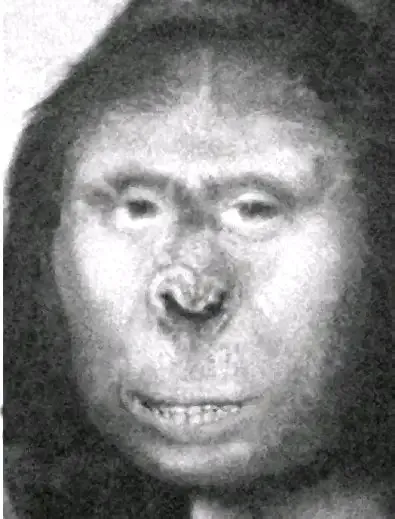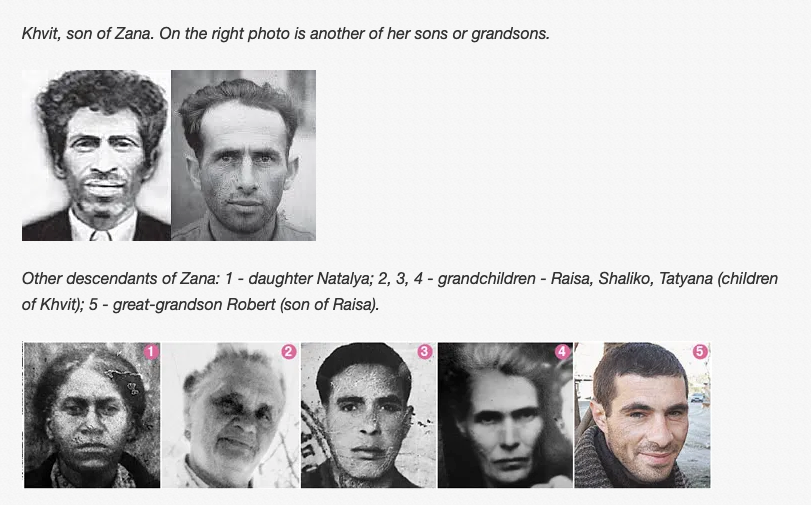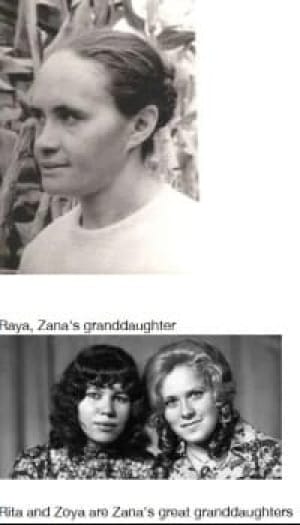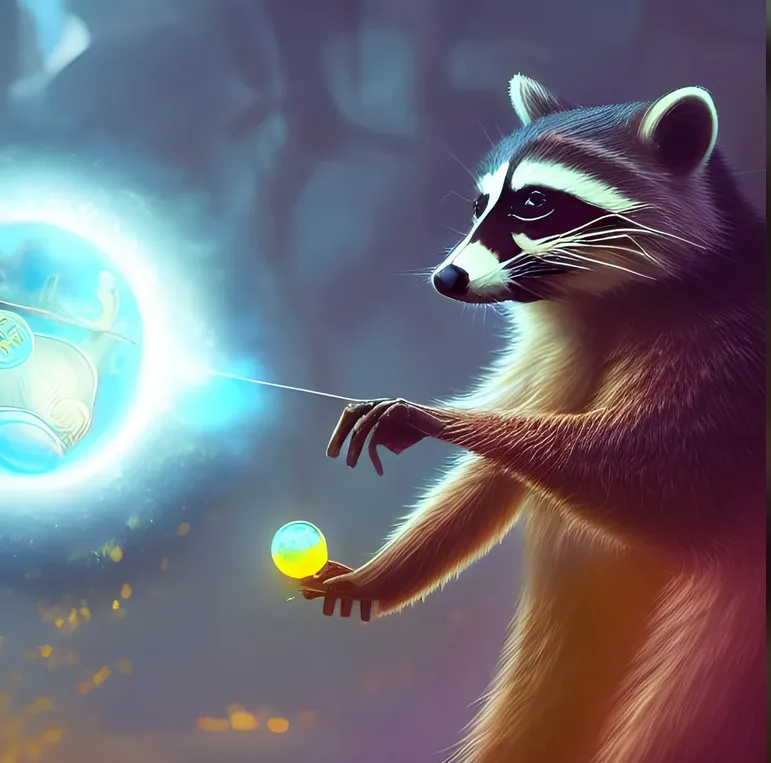The Life of Zana the Human
To accept the naturist’s version of Zana is to accept a chain of coincidences and chance survivals so long, as to be miraculous. I find it much more plausible that she was a representative of a relict human group.

She had something to tell us but we were too foolish to listen.
I believe in Sasquatchs. That is what we tend to call them in Canada. The Americans call them Bigfoot. People in the southern States call them “Skunk Ape”.
English speaking people elsewhere call similar phenomena “Yowie” or “Yeti” or “Abominable Snowman”. There are many other terms for them in other countries where they have had a presence. Russian and Turkic people call them the” Kaptar” or Almasti or “Almas”. The Chinese have their “Yeren.”
In Abkhasia they are called “Abnayou”. Zana was an Abnayou. She is the reason I started “believing in” Sasquatches.
“Believe in” is really a dumb phrase. I do not really believe in anything. I accept the existence of relict humans in many areas of the planets.
I came to this conclusion based on some reading I did about Zana of Abkhasia way back in the eighties, and some logical deductions. I also connected this with the Sasquatch stories which were starting to become popular at the time.
The Sasquatch was especially popular in my home town of Calgary, Alberta. A short drive west of the city, the Kananaskis began. This is a densely forested, hard to traverse area along the east slope of the Rocky Mountains.
It is perfect Sasquatch habitat. The Saskies seemed to have lived unnoticed there during earlier times. The aboriginals knew about them. They attracted more attention after the sixties, when more human development began in K country.
People kept getting the shit scared out of them by these weird creatures in the forest. Of course, no one ever got a good picture of one. People kept finding tracks, but were ignored.
The Sasquatch subject was always a source of juvenile humor in high school. Somebody’s mother must have been raped by a Sasquatch. Ha, ha. The pranksters regularly created Sasquatch hoaxes.
It all became a part of local culture. People erected Sasquatch statues. Eventually Stompin’ Tom Conners wrote a song about how a Sasquatch stole his wrist watch and was playing hopscotch in a tree crotch.
The eastern slopes of the Rockies remain a hot spot for Sasquatch sightings. People still go missing in these woods and there is debate about whether Sasquatches or Grizzlies are responsible. In many cases, I find the circumstantial evidence to point to Sasquatches.
No one ever comes up with “proof” of the Sasquatch. No one explains what exactly would “prove” Sasquatch and how you would get anyone to look at the proof. Few people consider the deeper questions posed by the relict human phenomenon.
A lady called Zana, who lived in Abkhasia back in the nineteenth century, is responsible for convincing me about relict humans. Abkhasia is a small country on the south slope of the Caucasus mountains, running some way inland from the black sea. It is presently a legal part of the country of Georgia, to the displeasure of its inhabitants.
For such a primitive and remote country, it has a remarkably long history. The area was called Colchis in ancient times. This is where Jason went to capture the golden fleece, in the Greek legend.
This region of the world has theoretically been part of many empires. It is full of “small peoples”, with distinct languages, and a mountain people’s attitude to outsiders.
No one knows how long the Abkhasian people have lived where they are. They have no written history. Their Avkaz language is similar to the language of the Circassians, themselves a very ancient people.
At the moment, Abkhasia is acting as an independent country. They are lobbying the Russian government, to the north of them, to take them over. Georgia has restricted access into Abkhasia, making travel there difficult.
In recent times, Abkhasia was under the harsh rule of the Ottoman empire. They enabled a Moslem elite to rule over a christian peasantry. There were frequent and futile revolts.
Sometime during the eighteenth century, the Abnayou population in the South Caucasus was thought to be out of control. They were encroaching on areas of humans settlement, stealing crops, abducting or killing people. Troops were sent in to eliminate them and the Abnayou problem seems to have gone away.
There was also a tradition in the Caucasus of aristocrats having a captured and "tamed" Abnayou or Almas in their courts as a status symbol. There are stories of them interbreeding with modern humans. The children were said to be like other modern people, but very strong, intelligent, and fearless.
In the 1860s, Russia conquered the Caucasus from the Turks in a very bloody war. The Moslems fled the country, which was partly depopulated. After this, a new aristocracy arose, with Russian support.
There are various stories of how this occurred, but sometime around 1870, a female Abnayou was captured and came to be owned by an Abkhasian aristocrat named Edgi Genaba. She was kept at his estate in Tkhina. She was named Zana, meaning “black one” in Avkaz.
At first she was treated brutally. After awhile, she began to be treated better. She came to accept her new home, where she was fed and cared for.
She was about six and a half feet tall, and immensely strong. She could easily perform physical chores like hoisting and carrying large sacks of grain. She is said to have outrun a horse.
She hated being indoors. She insisted on sleeping outdoors in all weather, despite being offered a place inside. She seemed to know how to light a fire, but made little use of the skill.
She would break up rocks for amusement, in a way similar to primitive tool making. The villagers tried to teach her to tend crops. She could not learn that.
She could not, or would not, learn the Avkaz language, but often seemed to be speaking in a strange language of her own. It was recalled that she never smiled, but had a strange kind of laugh when something amused her.
She annoyed the village women by refusing to wear clothes. She would run all through the village naked, grabbing food wherever she saw it. She could crack the hardest nuts with her teeth. She would shove whole bunches of grapes into her mouth.
She was often harassed by the village children and dogs. She would respond by throwing sticks and rocks with great accuracy. She could have easily ripped her tormentors to pieces but was intelligent enough to know that would have meant her own death.
The most interesting thing she did was to have children. She gave birth at least six times. The first two times, she tried to bathe her newborn in a cold river and it died.
The village women concluded she did not know how to care for a ‘human’ child’. They arranged to get the newborn away from her and found people willing to raise it. Four of her children grew to adulthood and at least two had children of their own.
This is very significant information. I will examine its significance in subsequent blogs.
The paternity of Zana’s children was a hot topic in old Tkhina. It was generally believed that Squire Egbi fathered most of them himself. Some local shepherds may have been responsible for some.
Zana liked alcohol. She would drink until she passed out. Then she would be impregnated.
Zana lived a long time at Tkhina. It was marveled that she never seemed to grow old. She never developed any illnesses or grey hair.
She died about 1890. The cause of her death seems to be a closed subject for the villagers who were interviewed about her life.
Zana’s exact appearance is a hot topic. The feature image of this article is, of course, of Zana. There is debate about whether it is a very good chalk drawing, from the description of people who had seen her in life, or an old glass plate photograph. I am inclined to say, the former.
She had black skin. She was covered with hair, which was black with a reddish tinge in places. Her head was slightly conical.
Her children did not inherit most of her features. They had no coat of hair. They did have dark skin.
Of her children, the most is known about her youngest son, Khwit. He was very tall and strong. He was said to be often short tempered and combative, but was intelligent and mastered most “peasant skills”. He sang well.
He worked as a farm laborer and handy man. With the advent of the Soviet Union, he became an enthusiastic communist and governing member of his farming cooperative. He died only a few years before the arrival of the Soviet commission investigating the existence of Almasty.
At some point in his life he got in a fight with someone who swung a hoe at him. The wound became infected and he had his right hand amputated. He died in a car crash.
Khwit was married twice and had three children. He had a sister by Zana, called Khodzanir, who also had children. There are sixteen known descendants of Zana.
It is hard to track exactly how many there are. Birth records were not kept in Abkhasia until the 1930s. It is not hard to understand why many did not want to be known. Many of Zana’s family moved away from Tkhina or Abkhasia and lost contact with their relatives.
Most descendants are reluctant to cooperate with scientific studies. There is also the potential social stigma against someone whose “grandmother was found in the woods”. This is combined with the Abkasian tendency to distrust outsiders.
Moreover, many descendants of Zana have been in some way abused by Almasty investigators. As is so common in efforts to study relict humans, it is swamped by people who are not real scientists, but cranks and attention seekers. Such people will squabble as they try to impose their pet narratives.
Genetic information from six of Zana’s matrilinear descendants has been collected. The bones of Zana and Khwit were dug up and examined. DNA was extracted from tooth pulp by modern techniques.
All this information was mishandled and the bones lost. What should have been the most important investigation in the history of anthropology was botched due to the foolishness of investigators. However, what we still have is very informative.


The Soviet Union set up a commission to study the Almasty phenomenon. They sent people to Abkhasia in 1962 to investigate the stories about Zana. At first they did reasonably competent and conscientious work.
DNA analysis was unknown in those times. They respected the wishes of Zana’s descendants, to not disturb graves. They interviewed people who had seen Zana.
Abkhasians are famed for their longevity. Many people were alive then who had seen Zana. They gave statements about her, which the commission collected.
The commission ran into trouble when it made the frequent mistake of investigators of relict humans. It mounted expensive and futile expeditions to find people who are very good at not being found. The commission was cancelled and many of its papers subsequently mislaid.
Some Soviet Almasty investigators persisted. Some were of the obsessed kind. Others seemed to be serving the ‘naturist’ agenda.
In 1971 and 1975, some obsessed investigators got local authorities to override the wishes of the family and dug up the graves. They threatened to tear up the whole cemetery if the locations of the graves were not pointed out. They then seemed to have been unable to do anything with this material.
Then the “no such thing as Almasty” crew arrived; the ‘naturists’. They harassed elderly witnesses to Zana. They had a theory that Zana was simply an abandoned child who grew up in the forest.
In the eighteenth century the Ottomans developed citrus plantations in the South Caucasus. The local labor proved unreliable so they brought in black slaves. At that time slavery was legal in the Ottoman Empire.
There was an east African slave trade, taking people from Zanzibar to be sold to the Turks. The Ottoman Empire gradually eliminated slavery between 1850 and 1890. By this time, Russia had conquered Abkhazia and freed all slaves.
These black people settled in villages along the black sea coast. They spoke Avkaz and were called “Arap”. These communities seem to have almost died out as the descendants intermarried with the local populations or moved away.
The naturist’s narrative about Zana has been that she was a retarded, deformed Arap child with hypertrichosis. That is, a rare genetic disorder that causes profuse hair growth all over the face and body of afflicted humans. She must have been abandoned in the woods.
Naturists are the people affiliated with the secret societies which control western societies. They think they are controlling science and steering it in what they think is a proper direction. They are behind most of the suppression of inquiry into relict humans.
They feel compelled to enforce the general replacement narrative about human evolution. That is, the modern human race emerged suddenly in Africa and totally replaced all earlier humans all over the world. Obviously, Zana did not fit this narrative.
So, the old witnesses to her were harassed. They must have been mistaken. Zana must have had bushy hair, like an Arap.
These old people insisted that Zana had straight hair. Some of them had visited the coast and seen the Arap people. Zana was very different from that.
This dispute dropped for awhile. It has been revived by the recent renewal of interest in relict humans. An Oxford professor of genetics, Brian Sykes, looked into Zana’s genetics.
Sykes was one of the pioneers of studying human evolution by examining the DNA of existing populations. He invented the tests which people now use to find out what ‘haplogroups’ they belong to, thus where their ancestors might have come from. Many of his discoveries contradict the naturist, “Out of Africa” narrative so he is not liked by such people.
Sykes got saliva swabs from Zana descendents, and DNA from drilling into teeth of Zana and Khwit. He was able to determine that Zana’s maternal haplogroup was L2b1b. All L haplogroups originate in Africa and are the origin of all the other mtDNA haplogroups.
The official story is that only the M and N haplogroups, branches of the L3 haplo, left Africa and colonized the rest of the world. However, L2b is a peculiar haplogroup which seems to turn up occasionally all over Europe and west Asia. In Africa, it is mostly found in west Africa, not in the east where the Ottoman slaves came from.
Sykes found very interesting things in the rest of Zana’s genome, but never published them. He died in 2020. It is unknown where all this material went to.
However, he wrote a book about his adventures with the Bigfoot and Yeti hunter community. It included his conclusions about Zana. He found two competing theories.
First, that Zana was an abandoned Arap. Second, that she was part of a relict human group which left Africa more than one hundred thousand years ago, and has been living alongside modern humans in the Caucasus mountains ever since. Sykes strongly rejected the former and supported the latter.
Of course, the world naturist network sprang into action. A researcher in Denmark, whose name I will not repeat, went at it again with the ‘abandoned Arap child’ theory of the origin of Zana. She published it in 2019.
She also defamed Sykes and refused to mention him or his own book by name. Her study has obvious flaws. She is full of shit.
If one wanted to confirm this theory about Zana’s DNA, one would go to the Arap populations and find out what their mtDNA haplos are. They are not a very large population and would have only a few haplogroups. As well, we must wonder what has happened to the organic material she got possession of.
There must be more to be learned from Zana’s nuclear DNA. She would also carry the Y-DNA which came only from her father. That would be very interesting.
Zana was an important lady. She did not live a really happy life. She had a mother and a father and would have been part of a band or tribe.
She did not seem fully grown when she was captured. She was somehow separated from her parents and her community, at a young age. This would not have been a happy story.
By herself, she destroys the general replacement theory. She is the most powerful argument we have for the existence of relict humans; Abnayou, Almasty, Kaptar, Sasquatch, Bigfoot. I accepted the existence of relicts after reading about Zana.
I have not thought much about the topic until recently. I have looked into it again. Serious evidence about relict humans is starting to fall into place, despite resistance from the ‘mainstream’ scientific community.
I agree with Professor Syke’s reasoning about it, which comports with my own thinking. The third prime law of thought is; that something exists when its non existence creates a contradiction. As well, Sykes cited the philosopher Hume, that one only believes a miracle when denying it requires believing an even bigger miracle.
No one is denying that Zana actually existed. She was either an Abnayou or an abandoned Arap child. If she was an Abnayou then she cannot have been the only one; there must have been a viable population somewhere.
If she was an Arap, she suffered from gigantism, hypertrichosis, and several other deformities, all in one unfortunate person. Plus, she was mentally retarded.
Yet somehow she found her way from the Arap villages on the coast, well inland to the forests near Tkhina. When captured, she was strong, fit, and vigorous. She remained healthy the rest of her life.
She could live outdoors in all weather, without difficulty. This requires a substantially different physiology from modern humans.
Abandoned children, when found in a forest, are always weak, sick, and starving. They are unable to care for themselves in that environment.
To accept the naturist’s version of Zana is to accept a chain of coincidences and chance survivals so long, as to be miraculous. I find it much more plausible that she was a representative of a relict human group.
As well, that Abnayous over in the Caucasus are real, but Sasquatches here in Canada cannot be, is a contradiction. So, Sasquatches are real.
In a future blog, I will finally get down to the significance of the ability of these relicts to interbreed with modern humans. Also, of course, philosophical issues arising from these facts.




Comments ()